Stalingrad landing
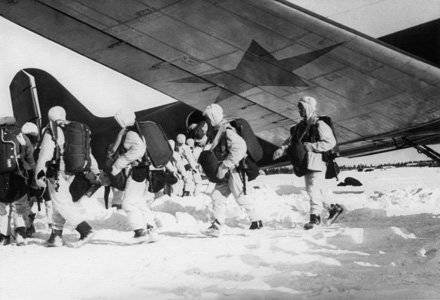 July 1942: The vanguards of the 6th German army engaged in fierce battles with the advanced detachments of the Stalingrad Front in the bend of the Don. In the early morning of July 20, the advance detachment of the 33rd Guards Rifle Division, reinforced tanks, attacked the village of Chernyshevskaya, occupied by the German 16th Panzer Division. And although the battle lasted from five in the morning until seven in the evening, the Soviet forward detachment was forced to retreat, losing 10 T-34 tanks. So the airborne units were one of the first to enter the Battle of Stalingrad. Just two months ago, the guardsmen changed aviation buttonholes for infantry. They were called the 3rd Airborne Corps and were in the reserve of the Headquarters of the Supreme High Command of the Red Army ...
July 1942: The vanguards of the 6th German army engaged in fierce battles with the advanced detachments of the Stalingrad Front in the bend of the Don. In the early morning of July 20, the advance detachment of the 33rd Guards Rifle Division, reinforced tanks, attacked the village of Chernyshevskaya, occupied by the German 16th Panzer Division. And although the battle lasted from five in the morning until seven in the evening, the Soviet forward detachment was forced to retreat, losing 10 T-34 tanks. So the airborne units were one of the first to enter the Battle of Stalingrad. Just two months ago, the guardsmen changed aviation buttonholes for infantry. They were called the 3rd Airborne Corps and were in the reserve of the Headquarters of the Supreme High Command of the Red Army ...Airborne Reorganization
Passing through the crucible of heavy battles of the 1941 of the year, the Soviet Airborne Forces, consisting of the remnants of five airborne corps, were significantly enlarged. The Soviet command wanted to have in their hands a powerful airborne grouping. In August, the post of Commander of the Airborne Forces (A. Glazunov was appointed to them) was introduced in 1941 of the year and the Red Army Airborne Forces Administration was created. In September, on the order “On the deployment of the Red Army airborne forces”, the formation of five new corps, five separate maneuverable brigades and ten reserve regiments began. Airborne units were formed from volunteers of ground forces and air forces, as well as 1922 recruits of birth. Serious attention was paid to the equipping of the corps. years in the airborne troops to October 10 1941 g. The best of the best were selected. In addition to good physical data, candidates for paratroopers should have the skills of parachute and rifle training, successfully pass the standards of the TRP and Osoaviahima. Young recruits differed high morale. Airborne units replenished with veteran paratroopers underwent combat training throughout the winter and spring of 50000.
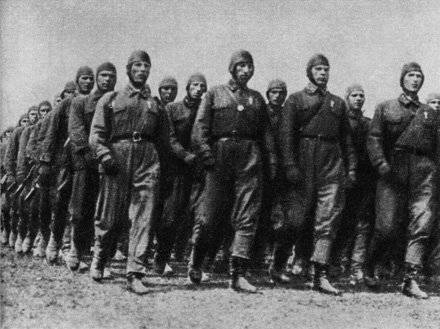 The Supreme Command headquarters in January 1942 created a large group of airborne troops around Moscow. It includes 1, 6, 7, 8, 9, 10 airborne corps (VDK), 1-I, 2-I, 3-I separate maneuverable airborne brigade (omddbr). Significant forces of the Airborne Forces were also concentrated in the North Caucasus: 2, 3 VDK, 4 and 5 omvdbr.
The Supreme Command headquarters in January 1942 created a large group of airborne troops around Moscow. It includes 1, 6, 7, 8, 9, 10 airborne corps (VDK), 1-I, 2-I, 3-I separate maneuverable airborne brigade (omddbr). Significant forces of the Airborne Forces were also concentrated in the North Caucasus: 2, 3 VDK, 4 and 5 omvdbr.In May, the 1942 and 2 airborne corps, which were under the operational control of the North Caucasus Front, were defeated into 3 and 32 Guards rifle divisions under the command of colonels after the defeat of the Soviet troops near Kerch. M.F. Tikhonov and A.I. Utvenko. For the first time, the Guards rank was conferred to units not for specific merits, but “in advance,” against future victories. Both divisions were sent to the Taman Peninsula, where they covered the withdrawal of Soviet troops from the Crimea. The divisions did not allow the enemy to cross the Kerch Strait and successfully fought with paratroopers of the enemy. Subsequently, 33-I adequately showed itself in the battle for the Caucasus in the battles of Tuapse, and 32-I - in the Battle of Stalingrad.
Hot was the tragic summer for the Red Army 1942 of the year. The defeat near Kharkov and Kerch, the fall of Sevastopol and Rostov-on-Don led to the collapse of the southern flank of the Soviet front. Due to the rapidly deteriorating situation in the Caucasus at the end of July, 1942, 1, 2, 3, 4, separate airborne brigades were transferred to the North Caucasus Front from the Airborne Forces; 5, 5, 6, 7, 8, 9, the guards rifle brigades in the 10 and 10 th guards rifle corps. September 11 The 4 of the year was precisely the Guardsmen who managed to stop the German 1942 Tank Army's offensive near the Ishcherskaya village in Chechnya.
The situation in the south demanded the mobilization of all forces and means. Especially the front needed well-trained and trained reserves. On August 2, at the Supreme Command headquarters, it was decided to reorganize eight airborne corps into guards rifle divisions and transfer them to the south.
6 August 1942, the Supreme Command Headquarters Directive, formed the 1-I Guards Army, which was directly subordinate to the Stavka. It consists of 37-I, 38-I, 39-I, 40-I, 41-I guards rifle divisions. Its first commander was appointed Lieutenant-General F. I Golikov. It was originally planned to send it, as well as the 35 and 36 divisions as part of the 57 army to the Southeastern Front, south of Stalingrad in early August, but the swift attack of the German forces overthrew the plans of the Soviet command ...
From our dossier
Reshaping the airborne corps into infantry divisions in the summer of 1942:
1 VDK - in 37 gv.sd (Major General V. G. Zheludev),
4 VDK - in 38 gv. Sd (Major General A. A. Onufriev),
5 VDK - in 39 gv. Sd (Major General S. S. Guryev),
6 VDK - in 40 gv. Sd (Major General A. I. Pastrevich),
7 VDK - in 34 gv. sd (major general I.I. Gubarevich),
8 VDK - in 35 gv. Sd (Major General V. A. Glazkov),
9 VDK - in 36 gv. Sd (Col. M. I. Denisenko),
10 VDK - in 41 gv. Sd (Col. N. P. Ivanov).
On the outskirts of Stalingrad
... At dawn of 23 July, the northern grouping of the 6 of the German army by superior forces struck the right flank of the 62 of the army. In the 84 Guards Rifle Regiment of the 33 Guards Division, the enemy had an advantage in 4 – 5 times in people, in guns and mortars - in 10 times, and in tanks it was absolute. But the guards fought steadfastly.
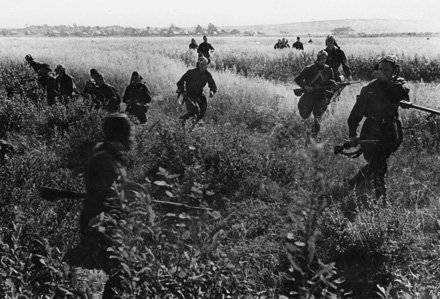 Guards Junior Sergeant P. O. Boloto, the first calculation number of anti-tank guns (PTR), along with his fighters, is located with two anti-tank guns at the junction of the defense zone of the 3 and 2 battalions of the regiment at the height of the village of Kletskaya. 23 July 30 German tanks, separated from the general group in 250 machines, broke into the location of the 2 Battalion and began to enter the flank and rear of the 3 Battalion. Surrounded by two calculations, accurate shots destroyed 15 enemy tanks, and forced the rest to turn back. In this battle, Swamp personally hit up 8 tanks. With the heroic defense of his positions, he and his comrades prevented the German armored group from breaking through to Stalingrad. For his heroism, P. O. Boloto was awarded the title Hero of the Soviet Union.
Guards Junior Sergeant P. O. Boloto, the first calculation number of anti-tank guns (PTR), along with his fighters, is located with two anti-tank guns at the junction of the defense zone of the 3 and 2 battalions of the regiment at the height of the village of Kletskaya. 23 July 30 German tanks, separated from the general group in 250 machines, broke into the location of the 2 Battalion and began to enter the flank and rear of the 3 Battalion. Surrounded by two calculations, accurate shots destroyed 15 enemy tanks, and forced the rest to turn back. In this battle, Swamp personally hit up 8 tanks. With the heroic defense of his positions, he and his comrades prevented the German armored group from breaking through to Stalingrad. For his heroism, P. O. Boloto was awarded the title Hero of the Soviet Union.But numerical superiority, more effective tactical training and air superiority were then on the side of the enemy. On August 8, a large grouping of the 62 Army as a part of the 28000 man got into German tank mites, and the 33 Infantry Division was cut. Later, the division commander A. I. Utvenko, in his letter to the writer Konstantin Simonov, recalled the events of those days: “By the time I ordered to break east I had up to three thousand people, seventeen guns, thirteen light tanks. Moved in two columns ahead through the ravines. Guns on hand. They broke through on a narrow front, losing about three hundred people. The Germans, overnight and morning, threw the infantry regiment east of us and again closed the ring ... Resisted to the end. I myself reloaded the Mauser five times. Sekli from automats. Several commanders shot themselves. Up to a thousand people were killed, but life was expensive. ” Subsequently, the character traits of Utvenko were reflected in the image of General Protsenko from the novel “Days and Nights” by Simonov. The units of the 33 division that left the encirclement were withdrawn to the reserve of the 62 army.
German troops managed to approach August 15 in the north - on 60 – 70 km, in the south - on 20 – 30 km. By creating a strike force of ten divisions, the enemy managed to capture a bridgehead on the left bank of the Don in the area of Peskovatka, 22 km in width, by August 45. In the current situation, the Soviet command was forced to enter the battle of the north of Stalingrad 1-th Guards Army, and 35-th Infantry Division to transfer to the 62-th Army, 36-th Infantry Division - in the 64-th army, 34-th Infantry Division - 28 th army to cover the Astrakhan direction.
The front commander in front of the 1-th Guards Army set the combat mission to keep the bridgehead in the small bend of the Don.
KS Moskalenko, appointed new army commander, recalled that at first she entered the battle on the bridgehead in the small bend of Don 40-I Guards Division under the command of Major-General A. I. Pastrevich.
Heavy fighting broke out around the height of 180,9 near the village of Oak to the north-west of the village Sirotinskaya.
August 17 in a fierce battle committed the feat 16 Guards under the command of Junior Lieutenant V. D. Kochetov. Defending this height, the guards repelled the attack of the adversary's vanguard. Could not take the height and company of the Nazis. Then the German infantry battalion, reinforced by 12 tanks, was thrown into the attack. Only at the cost of great losses the enemy took possession of it. All its defenders-guardsmen died, but did not retreat. The slopes of the height were littered with the corpses of German soldiers and officers, six enemy tanks were burning ...
The regiment command commander of the 1 th battalion of the guard captain A. Kuznetsov was assigned a combat task - to destroy the Germans who had strengthened at the height of 180,9 from Oak. On the night from 20 to 21 in August, the battalion, which was mainly paratroopers, under the command of Captain Kuznetsov, quickly mastered the tormented height. In the morning of August 21, the enemy threw 16 tanks into battle. The paratroopers bravely defended themselves in an unequal battle. Having secured themselves at the height, they repulsed 17 tank attacks during the day, shot down 11 tanks and destroyed the soldiers to the battalion. Personally, Kuznetsov hit a 3 tank, was wounded, but did not leave the battlefield. He was mortally wounded by a shot from a tank and died of his wounds ... But the paratrooper guards carried out the order and kept the height until reinforcements arrived. Fearless Combat was awarded the title Hero of the Soviet Union.
23 August, the German group, with strong aviation support, broke through the front at the junction of the 4 tank and 62 armies, and the advance units of the German 14 tank corps managed to reach the Volga near the market, dividing the forces of the Stalingrad Front into a narrow 8 kilometer corridor. During 23 – 28 in August, Soviet troops struck enemy forces from the north. During the bloody battles, both sides suffered heavy losses. 24 and 26 August, our units twice cut off the Germans from the main forces, but the enemy restored the position both times. Part of the 35, 38, 39 and 41 Guards divisions took part in these battles, and the 35 division guards managed to break into the defense zone of the 62 army.
The German tanks that had broken through threatened to cut off Stalingrad from our main forces. To eliminate this threat on August 23, an advance detachment of the 35 Guards Rifle Division, which included a machine-gun company under the command of Ruben Ibarruri (son of the leader of the Spanish Communists Dolores Ibarruri), was sent to the village of Kotluban. The brave actions of the vanguard and the powerful fire of the machine-gun company advancing the enemy was stopped. In this battle, the commander of the vanguard died, and Ibarruri assumed command of himself. The fascists continued their continuous attacks by superior forces, in just one night six such attacks were repelled, more than a hundred officers were killed. In this battle, Ibarruri was mortally wounded and 3 September 1942 of the year died, he was posthumously awarded the title Hero of the Soviet Union.
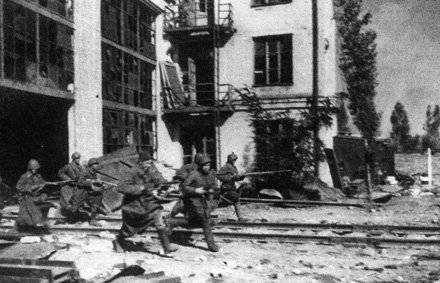 I.P. Gerasimov, a military commissar of the company of anti-tank guns of the 101 Guards Rifle Regiment of the 35 Guards Rifle Division of the 62 Army, on August 22 at the Voroponovo station headed a group of 10 armor-piercers and a platoon of machine gunners. A handful of people confronted 20 enemy tanks. Gerasimov with an anti-tank rifle together with the fighters repelled enemy attacks one after another. They were burned 5 German tanks. But the Nazis did not want to put up with this situation: the stronghold was subjected to massive air strikes and enemy artillery. The political leader appealed to his comrades: “Not a step back! The guardsmen are obliged to prove that they are not afraid of either tanks or aircraft. ”The political officer himself was seriously wounded, but his fighters, repelling another attack, burned down even 7 tanks. Gerasimov was also awarded the title Hero of the Soviet Union.
I.P. Gerasimov, a military commissar of the company of anti-tank guns of the 101 Guards Rifle Regiment of the 35 Guards Rifle Division of the 62 Army, on August 22 at the Voroponovo station headed a group of 10 armor-piercers and a platoon of machine gunners. A handful of people confronted 20 enemy tanks. Gerasimov with an anti-tank rifle together with the fighters repelled enemy attacks one after another. They were burned 5 German tanks. But the Nazis did not want to put up with this situation: the stronghold was subjected to massive air strikes and enemy artillery. The political leader appealed to his comrades: “Not a step back! The guardsmen are obliged to prove that they are not afraid of either tanks or aircraft. ”The political officer himself was seriously wounded, but his fighters, repelling another attack, burned down even 7 tanks. Gerasimov was also awarded the title Hero of the Soviet Union.But all this was fighting at the approaches to Stalingrad. 6-I German army was preparing to storm the city and needed reinforcement. Hitler’s command couldn’t transfer a single unit to reinforce the 6 army, because as a result of the offensive battles, 63, 21, and 1, the guard armies not only captured bridgeheads on the right bank of the Don, but also expanded them, thereby forging significant enemy forces.
Sturm of Stalingrad
On September 13, the enemy threw into the battle large masses of infantry and tanks and began to push our units in the areas of the central station and Mamayev Kurgan. This was a blow of exceptional strength. Despite the huge losses in their ranks, the invaders climbed right through. Soviet snipers, armor-piercing gunners, gunners, lurking in houses, basements and bunkers, observed, “like drunken nazis leaping from cars, playing harmonica, shouting furiously and dancing on the sidewalks. The invaders died by the hundreds, but fresh waves of reserves increasingly flooded the streets. ” East of the railway, to the station, the houses of specialists leaked machine gunners. The battle broke out in 800 meters from the command post of the army headquarters. There was a threat of capture by the enemy station, dismemberment of the army and access to the central ferry. In this situation, the Supreme Command Headquarters decided to transfer the 13 Guards Division to Major General A.I. Rodimtsev numbering about 10000 people in Stalingrad. This division also had a “landing” origin, its history she led from the 3 airborne corps of the first formation, in which Rodimtsev commanded the brigade. November 6 The 1941 Corps was reorganized into the 87 Rifle Division (second formation). In January, 1942, it was transformed into the 13 Guards Division.
Under the cover of the advanced detachment, the division for two nights 15 and 16 of September crossed over to Stalingrad. In a fierce hand-to-hand fight, Mamaev Kurgan was repulsed. During 17 September, the station building changed hands four times. The commander of the 1 battalion of the 42 battalion of the Guards Rifle Regiment, Lieutenant Colleganov reported to the battalion commander: “As long as I am alive, not a single bastard will pass! I myself am deaf to the hearing, I fall down, but we will die, and not back down! ” On the night of September 27, following the order of the company commander 42 of the Guards Rifle Regiment of the 13 Guards Rifle Division, Senior Lieutenant I.I. Naumov, the reconnaissance group headed by the machine gunner commander Sergeant Ya. F. Pavlov captured in the center of the city who miraculously survived four-storey residential building to gain a foothold in it and prevent the German forces from breaking through to the Volga at this place.
Pavlov sent a report to the command post of the 42 Guards Rifle Regiment, located opposite the destroyed mill: “The Germans were knocked out, entrenched. I ask for reinforcements. Pavlov. After that, his group kept the house, which went down in the history of the Battle of Stalingrad as "Pavlov's House" for almost three days. On the third day, reinforcements arrived at Pavlov's House: a machine-gun platoon of Lieutenant I. F. Afanasyev’s guard from the 3 machine-gun company, a group of armored soldiers and machine gunners. The garrison of the house increased to 24 people. The guards with the help of sappers improved the defense of the house, mined all the approaches to it, dug a small trench, through which communication was maintained with the command, delivered food and ammunition. Later, in the basement of the house, a field telephone with the call sign "Mayak" was installed. The house has become an impregnable fortress. The heroic defense of Pavlov's House lasted until the day of the liquidation of the German forces in the Stalingrad area. For 58 days (from 27 September 1942 of the year to 2 of February 1943 of the year), the legendary garrison of Soviet soldiers-guardsmen held the Pavlov House and did not give it to the enemy. And when the Nazis still managed to destroy one of the walls of the house, the soldiers jokingly replied: “We have three more walls. The house is like a house, with only a small ventilation. ” In the year 1945, Ya. F. Pavlov was awarded the title Hero of the Soviet Union.
The landing of the 13 division helped stabilize the situation in the city, although the compound suffered heavy losses. Despite the resistance shown by Soviet troops, the Germans still managed to break through to the Volga at the junction of the 62 and 64 armies. It was here that the remnants of the 33 and 35 divisions, which included the 864 and 454 fighter, selflessly defended themselves. V.I. Chuikov recalled: “On the southern outskirts of the city there is still a huge elevator building. From 17 to 20 September there were battles day and night. Not only the elevator as a whole, but also its individual floors and vaults passed from hand to hand several times. The commander of the 35 Guards Rifle Division Colonel Dubyansky told me by phone: “The situation has changed. We used to be at the top of the elevator, and the Germans at the bottom. Now we have knocked out the Germans from below, but they have penetrated upstairs, and there, in the upper part of the elevator, there is a battle.
The battalion of the 35 Division was reinforced by the marines of the 92 Infantry Brigade. Here is the testimony of a German officer, V. Hoffman, about the events of those days: “30 – 40 people remained in the companies. In the elevator, it’s not the people who fight, but the devils; neither the bullet nor the fire takes them ... only 40 killed Russians and only one seriously injured, unable to speak, found in the elevator ”. As a result of these battles, the 33-I and 35-I divisions were actually destroyed and brought to form.
September 27 began the second assault on Stalingrad. The enemy, changing the direction of the main strike north of Mamayev Kurgan to the Krasny Oktyabr settlement and along the Karuselnaya street to the Krasny Oktyabr factory, was counting on surprise and quick success in that direction. 26 – 28 September fierce fighting continued throughout the army’s defense front. It is difficult to say how many times a street or a quarter passed from hand to hand. These days, almost all the troops of the 62 Army were drawn into the battle along the front.
On the night of October 1, from the left bank of the Volga, began the crossing of the 39-I Guards Rifle Division. Its regiments, numbering 4082 people, were only half-staffed, in the companies there were 40 – 50 people. Major-General S. S. Guriev stood at the head of the division. This division earlier, 18 – 20 of September, as part of the troops of the 1 Guards Army, took part in the battles north of Stalingrad, where it suffered significant losses. However, all the companies were combat-ready, most of them were paratroopers, communists and Komsomol members. The 39 Division for many days defended the Red October plant, Guryev himself did not leave his command and observation post even when grenades of fascist machine gunners were torn at the entrance.
On the night of October 4, the 37-th Guards Division of Major-General V. G. Zholudev crossed to Stalingrad, whose decisive actions were later recalled by V. I. Chuikov: “This is indeed a guard. People are all young, tall and healthy, many of them were dressed in the uniform of paratroopers, with daggers and finns on belts. They fought heroically. When struck with a bayonet threw the Nazis through themselves, like bags of straw. Stormed in groups. Bursting into houses and basements, they used daggers and finca. The retreats did not know, surrounded by fought to the last of their strength and died with songs and exclamations: "For the Motherland!", "Do not leave and do not give up!".
And again, the introduction of new reserves helped stabilize the situation. In many ways, this was facilitated by a new, more effective assault tactic groups.
October 14 began another assault on Stalingrad. By this date, the 4 Division completely died in the battles for the Stalingrad Tractor Plant 14 – 37 of October, and after the battles for the Red October plant of 19 – 24 of October, 39 – 30 people remained in the 40 division.
With this participation in the Battle of Stalingrad of the former airborne units ended. At the final stage, 36 and 34 divisions of the Guards took part in Operation Ring. It should be noted that the compounds that suffered significant losses in the course of bloody battles were filled with ordinary personnel and gradually lost their amphibious backbone.
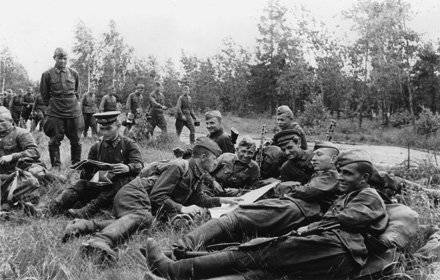 Of course, the participation of the former airborne units was only a small, but very important episode of the grandiose Stalingrad battle. Having received the rank of Guards in advance, they justified him with honor. At the most difficult moment of the Great Patriotic War, the paratroopers, stopping the enemy and allowing them to gain time to organize the offensive, fulfilled the mission of the strategic reserve assigned to them. Forced experience in the use of amphibious units as rifle units was subsequently repeatedly claimed. The airborne units that had already been restored by 16 on August 1942 of the year fought in March on the 1943 on the North-Western Front, in July on the 1943, near Kursk, and in June, on 1944, in Karelia. In October, the 1944 of the year was formed by the Separate Guards Airborne Army, in February the 1945-th was reformed into the 9-th Guards Army. At full strength, it was sent to the front. She had to participate in the liberation of Hungary, Czechoslovakia, Austria.
Of course, the participation of the former airborne units was only a small, but very important episode of the grandiose Stalingrad battle. Having received the rank of Guards in advance, they justified him with honor. At the most difficult moment of the Great Patriotic War, the paratroopers, stopping the enemy and allowing them to gain time to organize the offensive, fulfilled the mission of the strategic reserve assigned to them. Forced experience in the use of amphibious units as rifle units was subsequently repeatedly claimed. The airborne units that had already been restored by 16 on August 1942 of the year fought in March on the 1943 on the North-Western Front, in July on the 1943, near Kursk, and in June, on 1944, in Karelia. In October, the 1944 of the year was formed by the Separate Guards Airborne Army, in February the 1945-th was reformed into the 9-th Guards Army. At full strength, it was sent to the front. She had to participate in the liberation of Hungary, Czechoslovakia, Austria.
Information